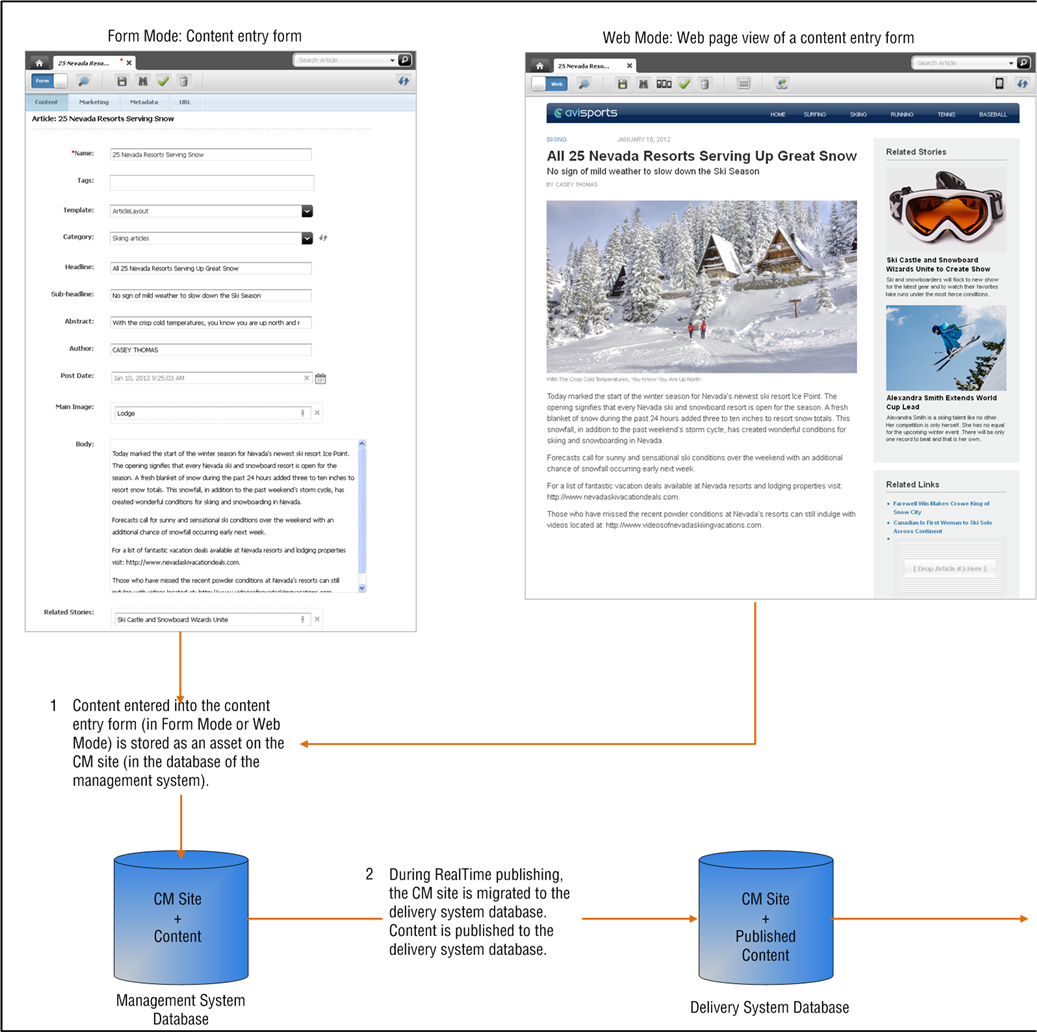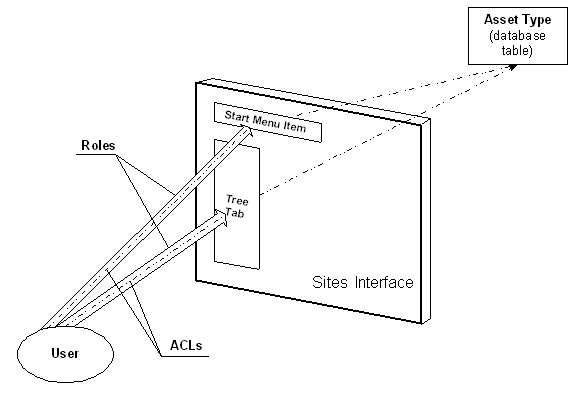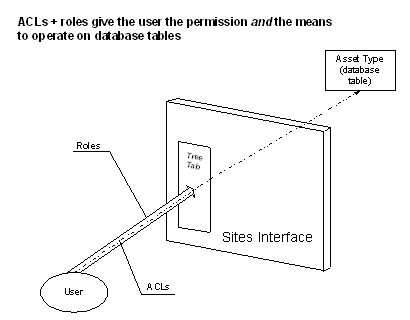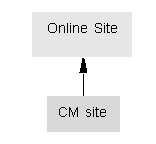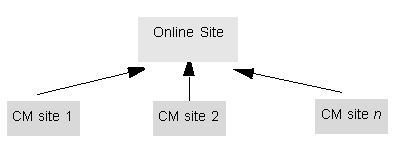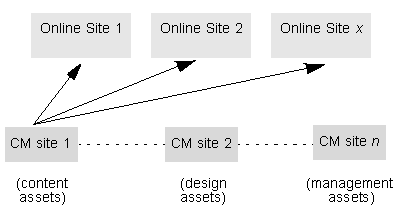1 Overview
As the administrator, you will be working with Content Management (CM) sites throughout your job, configuring the sites, replicating them, and managing their day-to-day use. Because they are a critical part of your work, you need to understand what CM sites are, and how they relate to the online site. This chapter provides an overview.
This chapter also outlines the administrator's job in the Oracle WebCenter Sites environment and offers guidelines for planning configuration tasks.
This chapter contains the following sections:
Note:
The following features are deprecated in WebCenter Sites 11g Release 1 (11.1.1.8.0): Sites Desktop, Sites DocLink.1.1 Introduction
As the Oracle WebCenter Sites administrator, your job is to build the foundation of your online site, specifically, its back end. The back end itself is a site (or set of sites) in the Oracle WebCenter Sites installation—a site where business users work to create their electronic assets, manage them, and deploy them to their audiences. Building the back end involves configuring the business users, linking them to content-entry forms as well as other authoring tools, and providing the users with publishing and delivery systems for serving the online site to browsers.
When the back end is configured, its users log on and fill in content-entry forms. The content they enter is then saved to tables in the Oracle WebCenter Sites database. When ready for delivery, the content is drawn programmatically from the database tables, formatted, and served to browsers as the online site. Figure 1-2, "Component Website and Relations" and Figure 1-2, "Component Website and Relations" illustrate the process flow, using a Mirror to Server publishing scenario.
In our scenario, Figure 1-1, "CM Site" depicts the smallest unit that can function as a back end: a user who has permissions to write to the Oracle WebCenter Sites database and to invoke the publishing-delivery systems. This unit, Oracle WebCenter Sites defines as a CM site. Oracle WebCenter Sites imposes no limit on the number of CM sites that you can configure for the back end of the online site, or the number of ways in which the sites can be configured.
Throughout your job as the Oracle WebCenter Sites administrator, you will be working with CM sites—configuring them, replicating them, and managing their day-to-day use. Because they are a critical part of your work, you need to understand how CM sites are defined, how they must be configured, and how they relate to the online site. This chapter provides an overview.
1.2 Online Sites
Although most Internet users don't need a definition of "online site," it is important to describe what an online site powered by Oracle WebCenter Sites is. Later in this chapter, we explain how online sites can be modeled by CM sites.
A WebCenter Sites-powered online site is the set of pages that an organization displays to its target audience of customers, clients, and casual visitors via Oracle WebCenter Sites. The online site can be accessible to the general public or it can be a password-protected site. It can also be a completely exclusive site, such as a corporate network or departmental network, operating strictly within the private domain.
Regardless of its nature, an online site originates from either a single CM site, or many CM sites, depending on which model you choose. Throughout our product guides, we use the term "online site" generically to refer to websites.
This content was created by a user populating one of the content-entry forms below.
This online site, a single page, was created from the asset shown in Figure 1-1.
Figure 1-2 Component Website and Relations
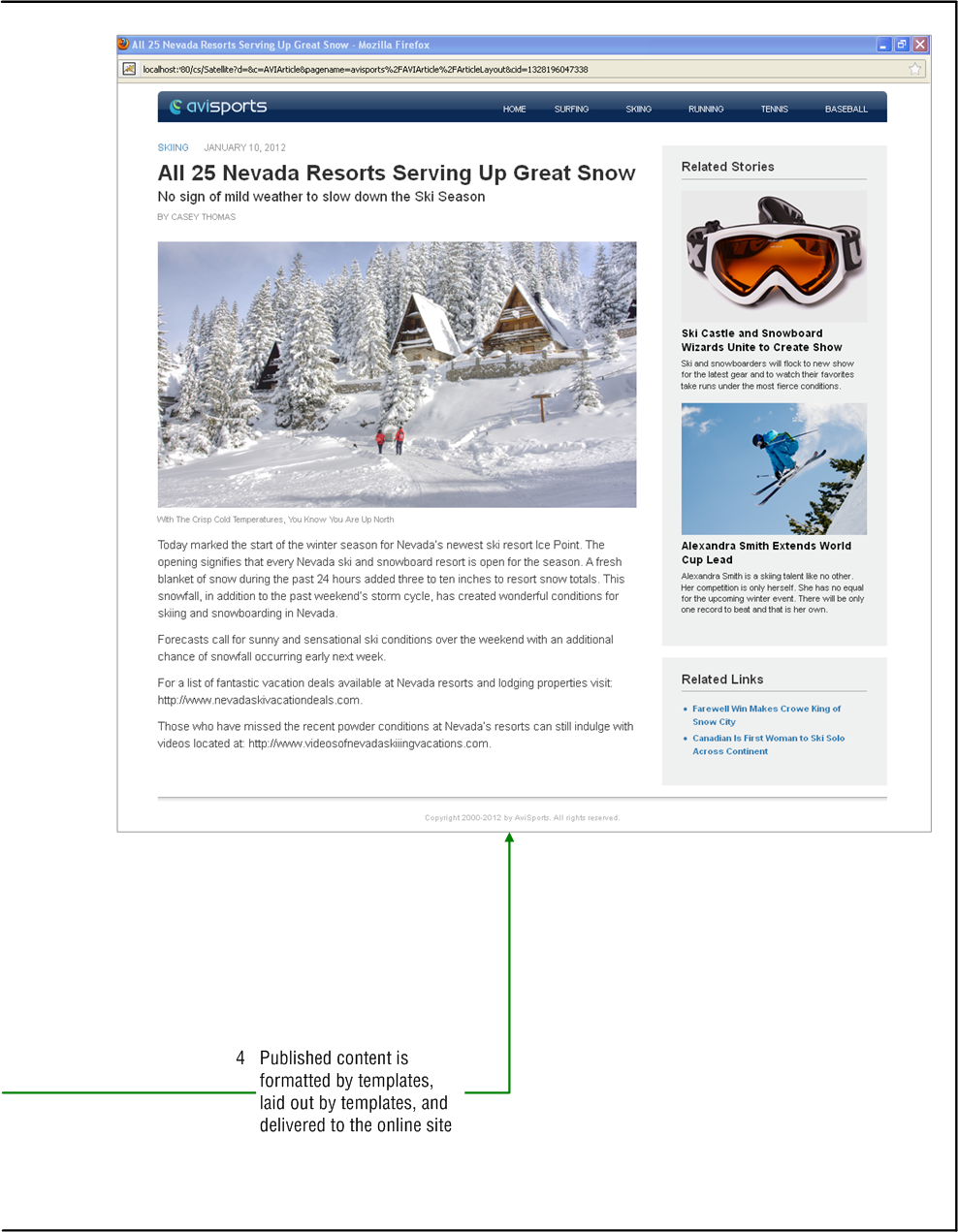
Description of ''Figure 1-2 Component Website and Relations''
1.3 CM Sites
A CM site is a content management unit within Oracle WebCenter Sites. It is the source of content for the online site and can represent either an entire online site or one of its sections.
Note:
From this point forward, when the term "site" is used without a qualifier, it means "CM site."A site is an object that you must configure in order to first define the authors and managers of the online site, and then provide them with the permissions and content management tools they will need: content-entry forms, content-rendering templates, workflow processes, start menu items, publishing methods, and a delivery system. The process of configuring a site involves creating not only the site components, but also associating the components with each other. Making the associations defines a site, similar to the one shown in Figure 1-3.
The site is identified by a name (also configured by the administrator), stored in Oracle WebCenter Sites' database, and listed in authorized users' interfaces. Users with the correct roles have access to the site. Within the site, roles manage the users' access to specific functions (such as a Start Menu Item) in the Oracle WebCenter Sites interface. ACLs manage the user's permissions to content (database tables). Through the interface functions (made accessible by roles), the user is able to actuate his permissions (as defined in the ACLs), and therefore operate on the database tables in order to author and manage specific types of content.
A Oracle WebCenter Sites system typically has many such sites, each one unique in its function and composition. When users log in to Oracle WebCenter Sites, they must also select a site where they will work. The site can be independent of other sites, or it can share assets with other sites, providing that the sites have a common set of users.
Note:
In this release, Oracle WebCenter Sites offers a site-replication utility called Site Launcher that speeds up the site creation process. Instead of creating sites from scratch, you can replicate established sites as necessary, modify the replicates, and spin them off as new sites in the Oracle WebCenter Sites environment.1.4 Configuration Components
Configuring a site involves using Oracle WebCenter Sites' administrator interface to access a system-wide configuration pool, select (or create) components that will make up the site, and associate the components with each other so they can function together to produce either the online site or one of its sections.
Table 1-1, "Site Components" lists site components, most of which are required. The optional components vary according to business needs and user preferences. Whereas developers are responsible for the code-based components, the administrator is responsible for all other components.
Site components are generally complex constructs, especially the data model. They are described in the sections that follow. Data modeling is described in detail in the Oracle Fusion Middleware WebCenter Sites Developer's Guide.
| Component | Required | Created by | See page … |
|---|---|---|---|
|
CM site definition |
Yes |
WebCenter Sites administrator |
6 |
|
Data model |
Yes |
Developers |
7 |
|
Users |
Yes |
WebCenter Sites administrator |
7 |
|
Roles |
Yes |
WebCenter Sites administrator |
9 |
|
Start menu items |
Yes |
WebCenter Sites or its administrator |
11 |
|
Workflow processes |
No |
WebCenter Sites administrator |
12 |
|
Publishing system |
Yes |
WebCenter Sites administrator |
12 |
|
User interface options |
No |
WebCenter Sites administrator |
12 |
This section contains the following topics:
1.4.1 CM Site Definition
A CM site definition is one of the components of a CM site. It consists of a site name and optionally a description, both specified by the administrator. The site name can represent an online site, a business topic, the work of a department, or yet another type of content. In any case, the site name establishes a business theme that users in the site are responsible for developing and maintaining.
When you specify a site name, Oracle WebCenter Sites creates a node to represent the site in its interface. It also appends several default sub-nodes for linking components to the site: an Asset Types sub-node for linking the data model to the site, a Users sub-node for linking users to the site, and two other nodes for enabling the optional user interfaces Desktop and DocLink. Descriptions of these components are given in the next sections.
For content providers, the site is a visibility control mechanism. The site provides authorized users access to certain content in the Oracle WebCenter Sites installation. When a site is properly configured, its name is displayed in the content providers' interfaces, allowing the content providers to select the site and navigate within it according to their roles and permissions.
1.4.2 Data Model
The data model is a component of a site. It comprises a set of asset types (database tables) and asset type definitions, coded by developers for content providers' use. To help developers equip content providers with the broadest possible set of content management options, Oracle WebCenter Sites supports three kinds of asset types.
-
Content asset types, which are structured repositories for content and by design reflect the business theme established by the site definition. For example, if you defined a site named "Social Events," suitable content asset types could be "Selected Moments in History," "The 20th Century's Greatest Events," and so on, since they pertain to the theme suggested by the site name.
From asset types, developers code asset type definitions. These are expressed in the WebCenter Sites interface as content-entry forms (such as the one in Figure 1-1, "CM Site"), whose fields prompt users for information that will be delivered to the online site (or reserved for internal use, if necessary). The set of fields defines the asset type; users' field entries define the asset (an instance of the asset type).
-
Design asset types, which are used by developers to code template assets, which render the content assets. (We distinguish template assets from content assets in order to distinguish presentation code from content.)
-
Management asset types, which are also used by developers to create tools such as simple searches and database queries that help content providers manage their content.
Ordinarily, developers test the asset types they create and pass them on to you so that you can link them to the site definition (through the Asset Types node) and complete another step in the site configuration process
Note:
Oracle WebCenter Sites provides a number of default asset types and allows developers to create their own. The asset types, their definitions, and the assets themselves are stored in the Oracle WebCenter Sites database as tables or table entries, and loosely referred to as content in this guide.For information about data modeling, see the Oracle Fusion Middleware WebCenter Sites Developer's Guide. We recommend that administrators read the guide to gain a basic understanding of asset types.
1.4.3 Users and Their Table-Level Permissions
Users are site components. In this guide, they are often referred to as content providers—people who use the developers' data model to author and manage content.
Content providers are the subject matter experts. They can be:
-
Authors of online content. Copywriters and designers would fall into this group.
-
Reviewers, who examine and edit the content that other users submit to them in order to ensure its quality. Examples of content reviewers include editors and art directors who review and modify the copy and designs that are submitted to them.
-
Content publishers, who ensure that content is ready to be delivered to the online site, and approve the content for delivery. An editor-in-chief could be a content publisher.
-
Content managers, who oversee the authoring, review, and publishing processes.
Each content provider must be identified to Oracle WebCenter Sites through a user account, which consists of a user name, a password, and Access Control Lists (ACLs), the foundation of Oracle WebCenter Sites' security system.
An ACL is a set of permissions to database tables. The permissions (such as read and write) are granted when the same ACL is assigned to both the table and the user. If no ACLs are common to a table and a user, the user has no permissions to the table.
For example, the system table named SystemUsers contains user account information. The table is assigned three ACLs: SiteGod, UserReader, and UserEditor. If a user is assigned one of the ACLs—UserReader, in our example—he can read the table. If the same user is assigned a second ACL—UserEditor—he can also edit the table. If the user is not assigned any of the ACLs, he has no permissions to the table.
Be aware, that while ACLs give the user permissions to operate on tables, they do not give the user the means to operate on the tables. For example, in our preceding scenario, the user's permissions to read and edit the table translate into permissions to use the View and Edit functions in the Oracle WebCenter Sites interface. However, the functions are hidden from the user, unless the same roles are assigned to both the user and the functions. For information about roles, see Section 1.4.4, "Roles."
In general, Oracle WebCenter Sites uses ACLs at two levels:
-
At the system security level, to provide authentication functionality and therefore prevent hackers from entering the Oracle WebCenter Sites environment.
-
At the interface level, to control users' permissions to database tables and, therefore, control the ability to use (but not view) interface functions through which the permissions are actuated.
Oracle WebCenter Sites provides a number of default system ACLs and pre-assigns them to system tables. You can re-use the ACLs, or configure your own and assign them to custom tables, as necessary. For more information about ACLs, see Chapter 4, "Working with ACLs and Roles" and Chapter 31, "System Defaults."
1.4.4 Roles
Whereas ACLs give the user permission to operate on database tables, roles give the user the means to operate on database tables. Roles determine whether the user has access to a site, and whether interface functions, such as Edit, Delete, and Start Workflow are exposed in the user's interface. If the functions are hidden, the user's permissions to database tables (as specified in the ACLs) cannot be actuated, leaving the user unable to operate on the tables. Roles also define groups of users, such as authors and editors. They are used to describe the groups' permissions (and therefore the users' permissions) to sites, the sites' content, to collateral (such as start menus for creating and locating content), and to workflow processes.
Roles are implemented in the same way as ACLs; that is, for a function to be displayed in the user's interface, the function and the user must be assigned the same role. To illustrate, we continue our previous scenario, where a user is given editorial permissions to the SystemUser table through the UserReader and UserEditor ACLs. To exercise those permissions, the user needs access to the Edit function in the Oracle WebCenter Sites interface. Edit is located in the Admin tab. To view the Admin tab, however, the user must be assigned the same role as the tab. By default, the tab is assigned the GeneralAdmin role; the same role must also be assigned to the user.
To summarize, the user gains full access to the database table only when he is assigned the ACLs of the table, and the role of the Admin tab. In practice, as in our scenario, roles and ACLs must be compatibly assigned—role assignments must support the permissions that are granted by ACL assignments.
In addition to displaying interface functions to site users, roles provide a way of grouping users according to their responsibilities on the site. Users with similar responsibilities can be assigned the same role(s). For example, administrative users need access to the Admin tab. All the administrators can be assigned the GeneralAdmin role and thereby be given access to the Admin tab.
Oracle WebCenter Sites defines several default system roles, all of which are pre-assigned to various functions in the Sites interface. Oracle WebCenter Sites also allows you to configure and assign your own roles. When choosing role names, consider the responsibilities of the users on the site and select the role names accordingly. Note that unlike ACLs (which are mapped to database tables), roles are mapped to sites and functions on the sites (which means that roles must be assigned on a per-user, per-site basis)
Note:
Unlike ACLs, roles are exposed to content providers for enlisting other content providers into workflow processes.1.4.5 Start Menus
A start menu is a site component. Items on the menu provide a way of coupling a user with the asset types he is to work with on the site. The coupling is accomplished by means of roles.
Oracle WebCenter Sites defines several start menus: New, which allows the user to create assets on the site; Search, which allows the user to look for and edit assets on the site; start menus for Sites Desktop, which enables Microsoft Word as an alternative interface to WebCenter Sites content-entry forms; and start menus for Sites DocLink which enables the document management interface.
A start menu item specifies:
-
The site(s) to which the start menu item applies
-
The asset type that users on the sites can work with
-
The roles that are allowed to create or search for assets of those types
-
The workflow processes (if any) in which the roles can participate
In other words, a start menu item determines which roles can create and search for assets of a specific type on a site, and which workflow processes the roles can participate in.
Oracle WebCenter Sites creates start menu items automatically and gives you the option to configure your own.
1.4.6 Workflow Processes
Workflow processes are optional constructs, mandated only by business needs, and used to regulate collaborations among content providers.
A workflow process enlists qualified users with complementary expertise to perform a sequence of operations that starts with the creation of a content asset, continues with review of the asset, and culminates in approval of the asset. Once approved, the asset is published to the delivery system by one of the users and finally, delivered as content to the online site.
Once workflows are configured, they can be specified in start menu items as processes that automatically begin the moment newly created assets are saved. Workflow processes can also be omitted from start menu items, to be invoked by users as necessary. For more information about workflow processes, see Chapter 10, "Creating and Managing Workflow Processes."
1.4.7 Publishing System
The publishing system is a site component. The publishing system gives users the means to migrate sites and their content from one system to another. The publishing methods that can be configured are: RealTime, Mirror to Server, Export to Disk, and export to XML. The structure of the site (that is, the database schema) is migrated by means of either the Mirror to Server or the RealTime publishing method. The content itself can be published at the administrator's discretion.
1.4.8 User Interface Options
Oracle WebCenter Sites supports a number of optional interfaces through which users can interact with content:
-
Oracle WebCenter Sites Desktop (Sites Desktop), which provides users with the familiar Microsoft Word interface as an alternative to the content-entry forms that are native to Oracle WebCenter Sites. Users can create their content in MS-Word documents, import the Word documents as assets into the Sites database, and from there, recall and edit the documents.
Note that Sites Desktop requires the content in Word documents to be structured. For example, when using Oracle WebCenter Sites Desktop to author content, the user opens a Word document, enters content, and structures the content by tagging it with the same field names as defined in the equivalent content-entry form. The tagging utility is embedded in the Word interface, and the selection of fields is determined by the administrator. When the Word document is saved, the content in its fields is parsed to the appropriate database table(s).
-
Oracle WebCenter Sites DocLink (Sites DocLink), which supports unstructured content in the flex asset family.
Sites DocLink provides a drag-and-drop interface for uploading and downloading unstructured content—documents, graphics, or other single binary files that are managed as flex assets. Sites DocLink also presents the hierarchical structure of any flex asset family in the Oracle WebCenter Sites database as folders and files in the Windows Explorer application.
-
Web Mode of the Contributor interface, which supports the editing of content directly on the rendered page. Regular Oracle WebCenter Sites users can make quick edits in context, while infrequent users can accomplish their work without having to learn the Oracle WebCenter Sites interface.
1.5 Summary
It is important to understand that the components of a site are not site-specific; the associations among them are.
Site components are constructs that either exist or must be created in a system-wide pool. From this pool, you select the components that must interact with each other in order to create a site; you then associate the components with each other, and assign them a site name. Because the components are system-wide, they are re-usable—components that are used to create one site can be used to build other sites.
Note that to content providers, site components appear to be site-specific. However, any assets that content providers create on the site are indeed specific to that site. The assets can be copied to other sites, or shared among them.
The options of sharing and copying site components play an important role in the modeling and replication of online sites, as explained in Section 1.6, "Content Management Models."
1.6 Content Management Models
As the administrator, one of your biggest decisions, whether you make it alone or with collaborators, is how to model the online site in the Oracle WebCenter Sites interface: as a single site or a set of sites. Which content management model you choose depends largely on the size of your online site and the nature of its content.
This section contains the following topics:
1.6.1 1:1 Model
The 1:1 model maps the online site directly to a single CM site. The CM site is the sole source of the online site.
The 1:1 model works efficiently for small online sites, where content tends to be limited, uniform, and managed by few users. For enterprise-level sites, however, pages often number in the millions and differ significantly in subject matter, content, presentation, and scope. Organizing large sites requires a model that can handle the complexities of the task.
1.6.2 1:n Model
The 1:n model maps the online site to multiple CM sites. Each section of the online site, whether logical or physical, maps to a certain CM site as its source. The CM sites can function independently of each other or overlap each other by sharing components and content.
For example, in a certain catalog site, content contributors who enter data about household goods never enter data about yard goods, so two separate sites are used to represent household goods and yard goods. Similarly, in a publication site where writers work independently of each other, the sports writers have a site that represents the sports news section, while the financial writers have a separate site that represents the financial news section. In each design, two sites contribute to one online site.
In a 1:n model, each site is unique; it has its own content types, templates, content providers, roles, workflow processes, and publishing mechanisms. Each site is the source of content for its corresponding online section.
When using a 1: n model, administrators have the option to configure sites to be independent of each other or to overlap each other by sharing components and content. An independent model works well when certain content needs to be segregated from other content. For example, the content is sensitive and must be handled only by certain content providers; or the content is so dissimilar that it needs to be handled by different specialists.
Overlapping sites, on the other hand, are used to support collaborations among remotely related content providers, such as those residing in different departments, or business units.
For example, consider the following scenario. A growing e-business specializing in mountain climbing disseminates mountain-climbing news and publishes a photograph album. It also sells gear and answers FAQs. The online site is clearly segmented into four sections: news, photos, gear, and FAQs. On many occasions, however, the news and photo sections share photographic content. In this scenario, one of your options is to create four sites: news, photos, gear, and FAQs such that news and photos share content. (Another one of your options is to create three independent sites: one for news and photos, one for gear, and one for FAQs.)
1.6.3 x:n Model
The x:n model maps multiple online sites to multiple CM sites. Of the three possibilities, this model is the most complex, but offers the greatest advantage to enterprise-level e-businesses.
In this model, content assets are localized on a given site, while the design and management assets are configured on separate sites from which they are shared to all other sites. This type of design allows the administrator to separate content from presentation and business logic.
Note:
To help administrators and other users understand sites and their relation to the online site, Oracle WebCenter Sites provides sample sites named avisports and FirstSiteII. Each sample site maps 1:1 to its online site. If the sample sites are installed, you can log in to the sites by following the login procedure in Chapter 2, "Administrator's Interface".1.7 Oracle WebCenter Sites Environment
Site configuration is a collaborative process that takes place in a Oracle WebCenter Sites environment rather than an isolated Oracle WebCenter Sites system. An enterprise-level environment typically consists of four different WebCenter Sites-powered systems: development, management, delivery, and testing, as Figure 1-10, "Oracle WebCenter Sites Environment" shows. Each system runs on its own database and at some point interacts with the other systems. One of the systems, testing, is an optional system that large organizations typically install for increased quality assurance.
As the administrator, you will work with all of the systems at one time or another. Your collaborators are developers, who work exclusively at the development system with you and with users whom you appoint as collaborators. This section summarizes the possible systems and your function in each of them.
Figure 1-10 Oracle WebCenter Sites Environment
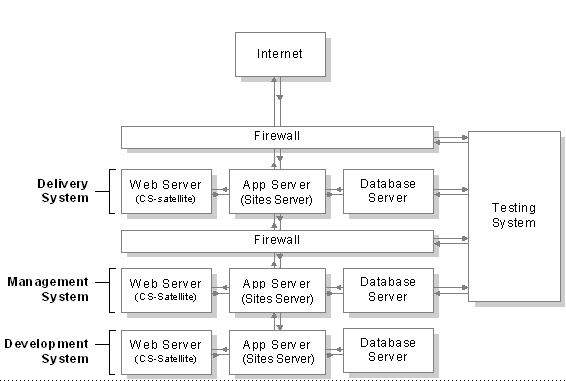
Description of ''Figure 1-10 Oracle WebCenter Sites Environment''
Note:
The names of the systems in your WebCenter Sites environment might vary from the names used in this guide. Generally, the management system is also called staging; the delivery system is also called production; and the testing system is also called QA or QA testing.-
The development system is responsible for planning and creating the framework of the online site: the data model that will be used by the CM sites and the data presentation templates.
-
The management system is the staging area, responsible for configuring site components (other than the data model), assembling the components (including the data model) into sites, making the sites available to users, and managing users' day-to-day activities on the sites. The users' responsibility is to develop and manage content for delivery to the online site.
-
The delivery system is the production area, which receives content for the online site from the management system and serves it to the target audience.
-
The testing system is where QA tests both the management and delivery systems, and the online site itself before its launch. When the testing system is absent, the development system doubles as the testing system.
The rest of this chapter describes your collaborators, your planning strategies, and your functions at each of the systems.
1.8 Administrator's Job
This section contains the following topics:
1.8.1 Collaborating
Before development begins you typically collaborate with a team comprising many different specialists:
-
Site designers
-
XML and JSP developers
-
Java application developers
-
Database administrators
-
System network administrators
-
Marketers and advertising staff
-
Business managers
-
Product managers, if you are developing a commerce site
-
Content providers
The job of the team is to establish functional requirements and design specifications for the management and delivery systems:
-
Page design
-
Caching strategy
-
Security strategy
-
Format vs. content
-
Data model
-
Content management model
Much of the preceding information is outlined in the Oracle Fusion Middleware WebCenter Sites Developer's Guide. The information presented in this guide is in the context of the administrator's job.
1.8.2 Planning
Planning is critical, as the decisions that you and your collaborators make will determine how developers will code system security, the data model, and the delivery system. Your job, in particular, concerns the management system, as described below.
During the planning stage, your job is to establish with collaborators (mostly business managers) the requirements and design of the management system, and relay the information to developers. Items to consider are listed below. The list is not meant to be exhaustive, but to help you start gathering and organizing information that is most critical to a successful start of the development cycle.
-
Content management model
-
Determine which of the models (1:1, n:1, and x:n) is most appropriate for your operation
-
Determine which content assets must be shared and which must copied. Do the same for template assets.
-
-
Site replication
Determine whether you will be replicating sites. If so, you must configure the source sites to conform to the requirements that are set by the replication process.
Developers must know your decision in order to code correctly. For example, if sites are to be replicated, the names of templates that will be copied to the new sites must not be hard-coded.
-
Data modeling
-
What types of assets should be created
-
Which asset types should use revision tracking
-
Which users must have access to which asset types? on which sites?
-
What types of templates need to be created by developers
-
-
User management methods
In addition to its native user manager, Oracle WebCenter Sites supports LDAP plug-ins, both hierarchical and flat-schema. Determine which method is appropriate for your environment. (Procedures in this guide use Oracle WebCenter Sites' native user manager system throughout.)
-
User management models
Determine the following:
-
How many users are needed
-
Who the users are
-
What permissions the users must be given to the database tables:
-
Which system ACLs the users must be assigned (without ACLs, no user accounts can be created).
-
Whether custom ACLs need to be created.
(Note that you may also need to create ACLs to assign to visitors of the online site in order to restrict them from accessing certain database tables.)
-
-
How many roles are needed
-
What types of roles are needed (writers, editors, illustrators). Make sure that the roles are compatible with the users' ACLs.
-
To which users the roles should be assigned.
-
-
-
Workflow processes
Workflow processes can be optionally attached to asset types to ensure that newly created assets of those types are automatically engaged in workflow.
-
Should workflow be implemented
-
If so, which asset types need workflow processes
-
How must the workflow processes be designed
-
Which users and roles need to participate in the workflow processes
-
-
Publishing system options
-
Which type of publishing needs to be configured
-
Whether publishing schedules need to be approved
-
-
User interface options
Determine which interfaces the users will need:
-
Contributor (Web Mode and Form Mode)
-
Admin
-
WEM Admin
-
Sites Desktop
-
DocLink
-
Use both this book and the Oracle Fusion Middleware WebCenter Sites Developer's Guide to help you make these decisions.
1.8.3 Development
When the specifications of the online and sites are established, you are ready to begin your work. As the Oracle WebCenter Sites administrator, you will be working on all systems in the WebCenter Sites environment during the development stage. (Once the online site is running, however, you will spend most of your time at the management system, a smaller fraction at the delivery system, and perhaps none at all at the development system.)
At each system, you have a specific set of jobs. While developers are responsible for the data model and other code-based components, you are responsible for all other aspects.
This section contains the following topics:
1.8.3.1 At the Development System
The development system is where coding takes place.
-
Your job is to provide developers with the specifications of the management system and to assist with content management operations, such as creating sites.
-
The developers' job is to:
-
Create sites with the same names as those that will be used on the management system
-
Code the data model (bearing in mind site-replication requirements:
-
Content asset types
-
Design asset types
-
Management asset types
-
-
Create sample assets of each type.
-
Test the data model.
-
Code templates and, in general, the framework of the online site.
-
Once the data model is complete and tested to the satisfaction of all collaborators, developers migrate the code to the management system
Note:
In your WebCenter Sites environment, developers might choose to not migrate the data model, but to re-create the data model on the management system.Note that once development is complete, the development system continues to operate. One of its ongoing functions is to revise the data model in response to the evolving needs of online site visitors, content providers, and administrators.
1.8.3.2 At the Management System
Configuration tasks that require no coding are typically completed at the management system. Here, your administrative work is not collaborative unless you choose to make it so. For example, because no data modeling or coding takes place at the management system, you have no need for assistance from developers. However, you can appoint developers (or other users) to be the site or workflow administrators, to manage specific sites or workflow processes for the system
Note:
On occasion, you will need help from developers; for example, you might want to add custom functionality to the tree tabs in Oracle WebCenter Sites' interface.At the management system, your job is the following:
-
Create the sites
Note:
In this release of Oracle WebCenter Sites, you can quickly spin off new sites by using the Site Launcher feature to replicate source sites. You can then modify the replicates as necessary. For information about site replication and selecting or creating the appropriate source sites, see Chapter 11, "Replicating Content Management Sites." -
Configure the users
-
Create their ACLs in Oracle WebCenter Sites, as necessary
-
Create user accounts, either through Oracle WebCenter Sites, or external user managers, such as LDAP plug-ins
-
Create roles in Oracle WebCenter Sites, as necessary
-
Assign users their roles for each site
-
-
Assemble the sites by
-
Associating the users with the sites
-
Associating the correct asset types and publishing system with the sites
-
-
Enable the users by
-
Assigning users their roles for each site
-
Using roles to associate users and asset types with start menu items
-
Using roles to associate users with interface functions such as tree tabs
-
Creating tree tabs, as necessary
-
-
Create and manage workflows
-
Enable revision tracking
-
Configure site and workflow administrators, as necessary
-
Configure the publishing process
-
Configure the users' interfaces, as necessary
1.8.3.3 At the Delivery System
The delivery system is configured by developers and typically does not involve an administrator until the system is ready for use. For Mirror to Server and RealTime delivery, the delivery system is the entire Oracle WebCenter Sites installation. For Export to Disk and Export to XML delivery, the delivery system is simply the web server component of the Oracle WebCenter Sites installation.
1.8.3.4 At the Testing System
The testing system is where QA analysts test the performance of both the management system and the delivery system, as well as the online site itself before its launch. If the testing system is absent, the development system doubles as the testing system. Ordinarily, you are not involved in testing.
1.8.4 Implementation
When the management and delivery systems are in use and the online site is running, you work almost exclusively at the management system, where you:
-
Manage the users
-
Adjust their permissions to database tables
-
Add, delete, and re-organize users
-
Create workflows
-
Configure the users' interfaces
-
-
Manage the publishing system
-
And otherwise respond to the needs of online site visitors, content providers, and the e-business
1.9 The Focus of This Guide
This guide focuses on the configuration tasks that you complete at the management system during the development stage, as described in Section 1.8.3, "Development." It is assumed that the data model resides on the management system by the time you begin your configuration tasks.
1.10 Administrator's Prerequisites
To function in the jobs that were described in the previous section, you must be equipped with a certain amount of information. This section summarizes the information you need to know or be familiar with.
-
Technical aspects of content management
Although you are not required to have a specific technical knowledge of programming and system architecture, a basic knowledge of the following is desirable:
-
Java
-
JSPs
-
Publishing
-
Databases and database management
-
Browsers
-
-
Your collaborators
For detailed information, see Section 1.8.1, "Collaborating" and the Oracle Fusion Middleware WebCenter Sites Developer's Guide.
-
Online site specifications
Online site specifications are typically prepared by site designers or the corporate communications department to define the site's audience, the site's size, its message and goals, the nature of the content, and the presentation style. Having an understanding of the online site will help you model the online site, plan sites, and collaborate efficiently with developers.
-
The Oracle WebCenter Sites environment
As the Oracle WebCenter Sites administrator, you can work with up to four different systems: development, management, delivery, and testing. Make sure you have a good understanding of the systems and your function at each of them. For detailed information, refer to the sections Section 1.7, "Oracle WebCenter Sites Environment," Section 1.8, "Administrator's Job," and the Oracle Fusion Middleware WebCenter Sites Developer's Guide.
-
Oracle WebCenter Sites' administrative interface and system defaults
The administrative interface provides you with site configuration tools, and access to system defaults such as ACLs, roles, and asset types. For information about the administrator interface, see Chapter 2, "Administrator's Interface." For information about system defaults, see Chapter 31, "System Defaults" and Chapter 32, "System Data: WebCenter Sites Database."
